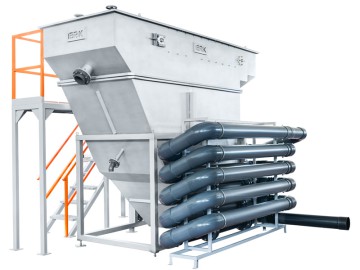FLOATING SYSTEMS
These systems can be used where the wastewater content tends to float. GESU uses state-of-the-art new generation DAF (Dissolved Air Flotation) systems as a wastewater flotation technique. Today, DAF units can find their place in almost all processes. Technically a DAF System;
It consists of the flocculator unit, in which the pollution load is made inclined to float by dosing chemicals into the waste water, the DAF Tank, where the pollution load is removed by floating and the waste water is ready to be discharged, and chemical dosing units. These systems, which are the most basic units of chemical treatment, are dimensioned according to flow rate, wastewater analysis and desired output wastewater parameters.
The biggest advantage of DAF systems is that it is a compact system that can work with high efficiency in a small area. Basically, DAF units can be operated in 2 different ways. In older methods, air is dissolved in water by using pressurization tanks, and the micro bubbles formed allow the pollution load in the wastewater to float. In the new generation DAF systems, microbubble control is provided by a "microbubble pump". Thus, the pollution load can be floated in a more controlled and efficient manner. In addition, Lamellas, which increase the surface load and allow the suspended particles to settle, are placed in the new generation DAF units to obtain the most efficient effluent results.
Flotation systems are manufactured by our company from AISI304 and AISI316 materials and in standard sizes according to the current waste water flow. The equipment constituting the system are produced in an integrated manner at the GESU factory, factory and field assembly are completed, put into operation and delivered to the customer.

